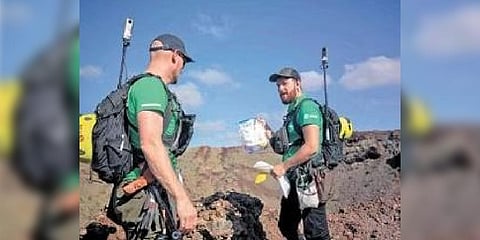

LOS VOLCANES NATURAL PARK: Kneeling on the edge of a deep crater, astronaut Alexander Gerst uses a chisel to collect a sample of volcanic rock which he carefully puts inside a white plastic bag. Gerst is not on the Moon, even if it looks like it. He is in the middle of Los Volcanes Natural Park on the island of Lanzarote in Spain’s Canary Islands, off the northwest coast of Africa.
With its blackened lava fields, craters and volcanic tubes, Lanzarote’s geology can be uncannily similar to that of the Moon and Mars—so much so that the European Space Agency (ESA) and NASA have for years been sending astronauts to the island train.
“This place has lavas that are very, very similar to the ones that we find on the Moon,” Gerst, a 46-year-old German astronaut with the ESA, said. He said the island was “a unique training ground”.
Gerst, who has completed two missions on the International Space Station, is one of about a dozen astronauts who have taken part in the ESA’s Pangaea training course in Lanzarote over the past decade. Named after the ancient supercontinent, Pangaea seeks to give astronauts as well as space engineers and geologists the skills needed for expeditions to other planets.
Trainees learn how to identify rock samples and collect them, do on-the-spot DNA analysis of microorganisms, and communicate their findings back to mission control.“Here, they are put into the field to experience the exploration of a terrain, which is something they will have to do on the Moon,” said Francesco Sauro, the technical director of the course.
Gerst said the Pangaea training course, which he has just completed, helps prepare astronauts to work in a remote setting on their own.“If we run into a problem, we have to solve it ourselves,” he said. He completed the Pangaea training along with Stephanie Wilson, one of NASA’s most senior astronauts. Both are possible candidates for NASA’s next crewed Moon missions.
Named for the goddess who was Apollo’s twin sister in ancient Greek mythology, the Artemis programme aims to return astronauts to the Moon’s surface as early as 2025, though experts believe that time frame might slip.